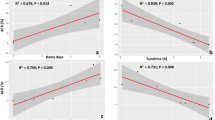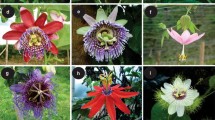Abstract
Three cultivated species of Ziziphus Mill. [Z. jujuba Mill., Z. mauritiana Lam. and Z. spina-christi (L.) Willd.] comprising a total of seventeen cultivars/genotypes were selected for a mating system study. Phenological stage determination showed an overlap in blooming between the three species during June. Intraspecific cross compatibility was evaluated for Z. jujuba and Z. mauritiana, and interspecific crosses between the three species were carried out during two flowering seasons. Following intraspecific hand cross-pollination, pollen tube formation and growth to the ovule 24 h after pollination (HAP) were observed in all three species. Although very low seed set was obtained following intraspecific Z. jujuba crosses, histological studies showed normal embryo formation and endosperm development, suggesting that double fertilization had occurred and that embryo development arrest occurred later. Following interspecific hand pollination, in vivo pollen grain germination and the formation of pollen tubes and their growth to the ovule 24 HAP were observed in compatible crosses, which also set fruit and seed. Viable embryos were obtained from Z. mauritiana × Z. jujuba, Z. mauritiana × Z. spina-christi and Z. spina-christi × Z. mauritiana crosses. Putative hybrids from these crosses were germinated in vitro, and the resultant plantlets were studied using flow cytometric analysis. Indications of true hybrid origin were obtained based on total 2C-DNA content of plantlets, but they died during the hardening-off process. This study showed that gene flow among these species is possible, thus increasing the potential that interspecific crosses can be used for genetic crop improvement.






Similar content being viewed by others
References
Ackerman WL (1961) Flowering, pollination, self-sterility and seed development of Chinese jujube. Proc Amer Soc Hort Sci 77:265–269
Anonymous (2002) Annual report. Central Institute for Arid Horticulture (CIAH), Bikaner, India
Arathi HS (2011) Selective embryo abortion in a perennial tree-legume: a case for maternal advantage of reduced seed number per fruit. J Plant Res 124:675–681
Asatryan A, Tel-Zur N (2013) Pollen tube growth and self-incompatibility in three Ziziphus species (Rhamnaceae). Flora Morphol Distrib Funct Ecol Plants 208:390–399
Azam-Ali S, Bonkoungou E, Bowe C, Dekock C, Godara A, Williams JT (2006) Breeding. In: Williams JT, Smith RW, Haq N, Dunsiger Z (eds) Ber and other jujubes, Ziziphus species. Fruits for the future 2 (revised edition). International Centre for Underutilised Crops, Southampton, UK, pp 79–90
Bushell C, Spielman M, Scott RJ (2003) The basis of natural and artificial postzygotic hybridization barriers in Arabidopsis species. Plant Cell 15:1–14
Chiarugi AN (1930) Parthenocarpia in Ziziphus sativa Gaertn. Bot Ital 37:287–312
Chunli L, Jin Z, Mengjun L (2010) Effect on embryo development and fruit set of Ziziphus jujuba ‘Dongzao’ by growth regulators spraying. Chin Agric Sci Bull 26:267–269 (in Chinese with English abstract)
Cisneros A, Garcia RB, Tel-Zur N (2011) Ovule morphology, embryogenesis and seed development in three Hylocereus species (Cactaceae). Flora 206:1076–1084
Cruden RW (1988) Temporal dioecism: systematic breadth, associated traits, and temporal patterns. Bot Gazette 149:1–15
Dafni A, Levy S, Lev E (2005) The ethnobotany of Christ’s Thorn Jujube (Ziziphus spina-christi) in Israel. J Ethnobiol Ethnomed 1:8
Danin A (2010) Ziziphus lotus with herbaceous vegetation, Mediterranean savannoid vegetation. In: Gingold B (ed) Vegetation of Israel and neighboring countries. Chapter A (part 6). The Hebrew University of Jerusalem, Jerusalem
De Hert K, Jacquemyn H, Van Glabeke S, Roldan-Ruiz I, Vandepitte K, Leus L, Honnay O (2012) Reproductive isolation and hybridization in sympatric populations of three Dactylorhiza species (Orchidaceae) with different ploidy levels. Ann Bot 109:709–720
DeGrandi-Hoffman G, Thorp R, Loper G, Eisikowitch D (1996) Describing the progression of almond bloom using accumulated heat units. J App Ecolog 33:812–818
Desai UT, Randhawa DB, Wavhal KN (1986) Floral biology of ber. J Maharashtra Agric Univ 11:76–78
Doležel J, Binarová P, Lucretti S (1989) Analysis of nuclear DNA content in plant cells by flow cytometry. Biol Plant 31:113–120
Drew RA, Siar SV, O’Brien CM, Megdalita PM, Sajise AGC (2006) Breeding for papaya ringspot virus resistance in Carica papaya via hybridisation with Vasconcellea quercifolia. Aust J Exp Agric 46:413–418
Galil J, Zeroni M (1967) On the pollination of Zizyphus spina-christi (L.) Willd. in Israel. Israel J Bot 16:71–77
Gazit S, Degani C (2002) Reproductive biology. In: Whiley AW, Schaffer B, Wolstenholme BN (eds) The avocado: botany, production and uses. CABI Publishing, Wallingford, UK, pp 101–133
Gu XF, Zhang JR (2005) An efficient adventitious shoot regeneration system for Zhanhua winter jujube (Ziziphus jujuba Mill.) using leaf explants. Plant Cell Rep 23:775–779
Guerra ME, Wunsch A, Lopez-Corrales M, Rodrigo J (2010) Flower emasculation as the cause for lack of fruit set in Japanese plum crosses. J Am Soc Hort Sci 135:556–562
Gupta RB, Sharma S, Sharma JR, Sareen PK (2003) Cytological studies in some varieties of genus Ziziphus. Nat J Plant Imp 5:19–21
Hammer K (2001) Rhamnaceae. In: Hanelt P, IPK (eds) Mansfeld’s encyclopedia of agricultural and horticultural crops, vol 3. Springer, Berlin, pp 1141–1150
Hancock CN, Kondo K, Beecher B, McClure B (2003) The S-locus and unilateral incompatibility. Philos Trans R Soc Lond B358:1133–1140
Heslop-Harrison J, Heslop-Harrison Y (1970) Evaluation of pollen viability by enzymatically induced fluorescence: intracellular hydrolysis of fluorescein diacetate. Stain Technol 45:115–120
Hiscock SJ, Dickinson HG (1993) Unilateral incompatibility within the Brassicaceae: further evidence for the involvement of the self-incompatibility (S)-locus. Theor Appl Genet 86:744–753
Islam MB, Simmons MP (2006) A thorny dilemma: testing alternative intrageneric classifications within Ziziphus (Rhamnaceae). Syst Bot 31:826–842
Josan JS, Jawanda JS, Bal JS, Singh R (1980) Studies on the floral biology of ber. Flowering habit, flower bud development, time and duration of flowering, floral morphology, time of anthesis and dehiscence. Punjab J Hort 20:156–161
Karale AR, Keskar BG, Dhawale BC, Kale PN (1992) Fruit set in intervarietal hybridization in ber. J Maharasthra Agric Univ 17:140–141
Liu MJ, Cheng CY (1995) A taxonomic study of the genus Ziziphus. Acta Hortic 390:161–165
Liu MJ, Qi YF (2004) Embryo rescue of Chinese jujube (Ziziphus jujuba Mill.). Acta Hortic 663:479–482
Liu P, Liu M, Wang J, Yan C (2008) Investigation on the characteristics of fruiting and seed development in Chinese jujube (Ziziphus jujuba Mill.). International Jujube symposium 2008, Baoding, China S-05-07, p 41 (Abstract)
Lyrene PM (1983) Flowering and fruiting of Chinese jujubes in Florida. HortScience 18:208–209
Mehrotra NK, Gupta MR (1985) Pollination and fruit set studies in ber (Ziziphus mauritiana Lamk.). J Res Punjab Agr Univ 22:671–674
Miyashita C, Mii M, Aung T, Ogiwara L (2012) Effect of cross direction and cultivars on crossability of interspecific hybridization between Vaccinium corymbosum and Vaccinium virgatum. Sci Hortic 142:1–6
Mizrahi Y, Nerd A (1996) New crops as a possible solution for the troubled Israeli export market. In: Janick J (ed) Progress in new crops. ASHS Press, Alexandria, VA, pp 37–45
Mori T, Kuroiwa H, Higashiyama T, Kuroiwa T (2006) Generative cell specific 1 is essential for angiosperm fertilization. Nat Cell Biol 8:64–71
Murti RH, Kim HY, Yeoung YR (2012) Morphological and anatomical characters of ploidy mutants of strawberry. Int J Agric Biol 14:204–210
Pareek OP (1983) The ber. ICAR, New Delhi, India
Pareek OP (1996) Indian jujube and pomegranate. In: Paroda RS, Chadha KL (eds) 50 years of crop science research in India. ICAR, New Delhi, India, pp 557–573
Pareek OP (1998) AICRP (arid fruits). In: Ghosh SP, Bhatnagar PS, Sukumaran NP (eds) 50 years of horticulture research in India. Division of Horticulture, ICAR, New Delhi, pp 150–158
Pareek OP (2001) Ber. International Centre for Underutilized Crops, Southampton, UK, pp 248–266
Pasonen H-L, Käpylä M, Pulkkinen P (2000) Effects of temperature and pollination site on pollen performance in Betula pendula Roth—evidence for genotype-environment interactions. Theor Appl Genet 100:1108–1112
Possingham JV (1990) Under-exploited wild species that have potential for horticulture. Adv Hort Sci 4:49–55
Ranney TG, Fantz PR (2006) ×Gordlinia grandiflora (Theaceae): an intergeneric hybrid between Franklinia alatamaha and Gordonia lasianthus. HortScience 41:1386–1388
Rieseberg LH, Willis JH (2007) Plant speciation. Science 317:910–914
Said O, Khalil K, Fulder S, Azaizeh H (2002) Ethnopharmacology survey of medicinal herbs in Israel, the Golan Heights and the West Bank region. J Ethnopharmacol 83:251–265
Saied A, Gebauer J, Hammer K, Buerkert A (2008) Ziziphus spina-christi (L.) Willd. A multipurpose fruit tree. Genet Resour Crop Evol 55:929–937
Schirarend C (1991) The systematic wood anatomy of the Rhamnaceae Juss. (Rhamnales). I. Tribe Zizipheae. IAWA Bull 12:359–388
Shukla AK, Shukla AK, Vashishtha BB (2004) Ber, In: Shukla AK et al. (eds) Fruit breeding: approaches and achievements. International Book Distributing Company, Lucknow, India pp 217–232
Singh KK (1964) The ber in India. Farm bulletin. Indian Council of Agricultural Research, New Delhi, pp 17–31
Singh NP, Vohra JN, Hazra PK, Singh DK (2000) Ziziphus. In: Singh NP et al. (eds) Flora of India, vol 5. Botanical Survey of India, Calcutta, India, pp 221–245
Susín I, Álvarez JM (1997) Fertility and pollen tube growth in polyploidy melons (Cucumis melo L.). Euphytica 93:369–373
Talluri RS (2012) Interploidy interspecific hybridization in Fuchsia. J Genet 91:71–74
Teaotia SS, Chauhan RS (1963) Flowering, pollination, fruit set and fruit drop studies in ber (Ziziphus mauritiana Lamk.). I. Floral biology. Punjab J Hort 3:60–70
Teaotia SS, Chauhan RS (1964) Flowering, pollination, fruit set and fruit drop studies in ber (Ziziphus mauritiana Lamk.) II. Pollination, fruit set, fruit development and fruit drop. Ind J Hort 2:40–45
Tel-Zur N, Schneider B (2009) Floral biology of Ziziphus mauritiana (Rhamnaceae). Sex Plant Reprod 22:73–85
Tian HQ, Ma DZ (1987) The embryological observation on a parthenocarpy’s Ziziphus jujuba Mill. Acta Bot Sin 29:29–33 (in Chinese with English abstract)
Wang JR, Zhang M, Liu MJ (2009) Plant regeneration from immature embryo in Chinese jujube (Ziziphus jujuba Mill.). Acta Hort 840:262–272
Weekley CW, Race T (2001) The breeding system of Ziziphus celata Judd and D.W. Hall (Rhamnaceae), a rare endemic plant of the Lake Wales Ridge, Florida, USA: implications for recovery. Biol Conserv 100:207–213
Weissmann S, Feldman M, Gressel J (2005) Sequence evidence for sporadic intergeneric DNA introgression from wheat into a wild Aegilops species. Mol Biol Evol 22:2055–2062
White LM (1995) Predicting flowering of 130 plants at 8 locations with temperature and daylength. J Range Manag 48:108–114
Widmer A, Lexer C, Cozzolino S (2009) Evolution of reproductive isolation in plants. J Hered 102:31–38
Wolf DE, Takebayashi N, Rieseberg LH (2001) Predicting the risk of extinction through hybridization. Conserv Biol 15:1039–1053
Xueying Z, Shiqi P, Zhenhuai G (2004) Studies on the pollination, fertilization and embryo development of Chinese date ‘Wu-He-Zao’ (Ziziphus jujuba). Sci Silvae Sin 40:210–213 (in Chinese with English abstract)
Zietsman PC, Botha FC (1992) Flowering of Ziziphus mucronata subsp. mucronata (Rhamnaceae): anthesis, pollination and protein synthesis. Bot Bull Acad Sin 33:33–42
Acknowledgments
The authors dedicate this work to the late Dr. B. Schneider. This work was supported by the Jewish Fund for the Future, Goldinger Foundation and Rosenzweig-Coopersmith Foundation.
Author information
Authors and Affiliations
Corresponding author
Appendix
Appendix
Taxon; Voucher specimen, Collection locale; Herbarium.
Origin of the material used
Ziziphus jujuba Mill. “Lang”; HUJ-102630; Israel; Jerusalem, HUJ. Z. jujuba “Li”; HUJ-102631; Israel; Jerusalem, HUJ. Z. jujuba “Ben Li”; HUJ-102632; Israel; Jerusalem, HUJ. Z. jujuba “Tamar”; HUJ-102633; Israel; Jerusalem, HUJ.
Ziziphus mauritiana Lam. “Q-29”; HUJ-102634; Israel; Jerusalem, HUJ. Z. mauritiana “Seb”; HUJ-102635; Israel; Jerusalem, HUJ. Z. mauritiana “Gola”; HUJ-102636; Israel; Jerusalem, HUJ. Z. mauritiana “Umran”; HUJ-102637; Israel; Jerusalem, HUJ. Z. mauritiana “B5/4”; HUJ-102638; Israel; Jerusalem, HUJ. Z. mauritiana “Kaithali”; HUJ-102639; Israel; Jerusalem, HUJ.
Ziziphus spina-christi (L) Willd. “Nehemia 1.2”; HUJ-102640; Israel; Jerusalem, HUJ. Z. spina-christi “OrHaNer 1.3”; HUJ-102641; Israel; Jerusalem, HUJ. Z. spina-christi “Bachara 1.4”; HUJ-102642; Israel; Jerusalem, HUJ. Z. spina-christi “OrHaNer 2.1”; HUJ-102643; Israel; Jerusalem, HUJ. Z. spina-christi. “Bachara 2.2”; HUJ-102644; Israel; Jerusalem, HUJ. Z. spina-christi “Hadid 2.3”; HUJ-102645; Israel; Jerusalem, HUJ. Z. spina-christi “Nehemia 2.4”; HUJ-102646; Israel; Jerusalem, HUJ.
Rights and permissions
About this article
Cite this article
Asatryan, A., Tel-Zur, N. Intraspecific and interspecific crossability in three Ziziphus species (Rhamnaceae). Genet Resour Crop Evol 61, 215–233 (2014). https://doi.org/10.1007/s10722-013-0027-8
Received:
Accepted:
Published:
Issue Date:
DOI: https://doi.org/10.1007/s10722-013-0027-8




